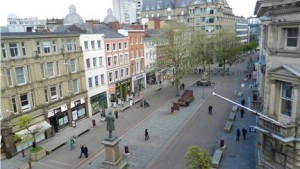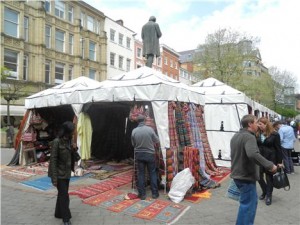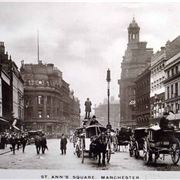
Eighteen days of market fun from May 22nd to June 8th.
Throughout the eighteen days, St Ann’s focal point will be The Orangery, a marquee housing a variety of table top stalls selling crafts, books, pottery, retro clothing and a selection of handmade gifts.
The line-up of events will change each weekend featuring a series of tastings, poetry readings and vintage themed tea rooms. Highlights also include an independent book market (7 -8 June) with emerging literary talent and a vinyl and record fair (4 June) – a first for Manchester markets.
Councillor Rosa Battle, Manchester City Council executive member for culture and leisure, said: “This June the Spring Festival of Markets will bring a vibrant, lively atmosphere to St Ann’s Square.
“Featuring poetry readings, a record fair, vintage fashion and a cornucopia of delicious treats and drinks the market will be a must visit destination.”
St Ann’s Square Markets – The History:
Markets in St Ann’s Square aren’t a new idea. Hand around long enough and you might catch the whiff of historical and geographical predestination. Markets began in Manchester right here in the early 1200s for three days around St Matthew’s Day, September 21.
This was an annual market mainly trading livestock. The area was then Acresfield, outside the small town which clumped around the parish church, now the Cathedral. One tradition states that the first animal that entered into the market area was pelted to death with acorns or stones – this probably isn’t part of the entertainment over these ‘Spring Markets’.
Eventually the main weekly markets settled in, understandably, the former Market Place, roughly New Cathedral Street between Marks and Spencer and Ted Baker, and along the disappeared street of Smithy Door. Fruit, grain and veg were sold along Fennel Street, which is why the Corn Exchange (now the Triangle) developed close to the site.
 The markets subsequently got in the way. By the middle of the nineteenth century the city with Salford was a teeming metropolis of around 400,000 packed into not much more than the area we consider to be the city centre. It would have been like Calcutta.
The markets subsequently got in the way. By the middle of the nineteenth century the city with Salford was a teeming metropolis of around 400,000 packed into not much more than the area we consider to be the city centre. It would have been like Calcutta.
The annual St Ann’s Fair/Market, in particular, had got messy and drunken. So it was pushed down to Knott Mill, the area on Liverpool Road where the Air and Space Gallery of the Museum of Science and Industry sits. It then got even more riotous, so the city killed it. The other markets were transferred to the Shude Hill/Smithfields area of town: the Manchester Craft and Design Centre, a former fish market, is one of the original buildings.
In 1973 these markets were exiled to Openshaw. The city, apart from a few traders on Church Street, lost a 750 year tradition of street markets, until of course the Christmas markets revolution began to spread through the year a decade or so ago.
